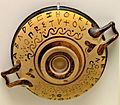Psi (letter) facts for kids
 |
|||
Quick facts for kids Greek alphabet |
|||
|---|---|---|---|
| Αα | Alpha | Νν | Nu |
| Ββ | Beta | Ξξ | Xi |
| Γγ | Gamma | Οο | Omicron |
| Δδ | Delta | Ππ | Pi |
| Εε | Epsilon | Ρρ | Rho |
| Ζζ | Zeta | Σσ | Sigma |
| Ηη | Eta | Ττ | Tau |
| Θθ | Theta | Υυ | Upsilon |
| Ιι | Iota | Φφ | Phi |
| Κκ | Kappa | Χχ | Chi |
| Λλ | Lambda | Ψψ | Psi |
| Μμ | Mu | Ωω | Omega |
| Other letters | |||
| Ϝϝ | Digamma | Ϟϟ | Koppa |
| Ϛϛ | Stigma | Ϡϡ | Sampi |
| Ͱͱ | Heta | Ϸϸ | Sho |
| Ϻϻ | San | ||
Psi (written as Ψ for uppercase and ψ for lowercase) is the 23rd letter in the Greek alphabet. It makes a "ps" sound, like in the word "psychology." You can find it in both Ancient and Modern Greek words. In the old system of Greek numerals, Psi had a value of 700. One letter that came from Psi is the Cyrillic letter Ѱ.
What is Psi?
Psi is a special letter with a long history. It's part of an alphabet that has been used for thousands of years! The Greek alphabet is important because it influenced many other alphabets, including the one we use today.
Psi in Numbers
Long ago, the Greeks didn't use numbers like 1, 2, 3. Instead, they used letters from their alphabet to represent numbers. Psi, being the 23rd letter, was given the value of 700. This system helped them write down numbers for trade, counting, and more.
Psi in Science and Math
Even today, Psi is used as a symbol in many areas of science and mathematics.
- In math, the uppercase Ψ is sometimes used to stand for groups of ideas or statements in logic.
- The lowercase ψ can be used in more advanced math to represent different kinds of calculations, like those involving Fibonacci numbers.
- Scientists and mathematicians also use Psi in complex formulas and equations, but these are often for very specific and advanced topics.
Related pages
Images for kids
See also
 In Spanish: Ψ para niños
In Spanish: Ψ para niños


